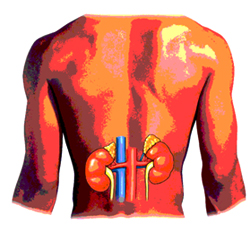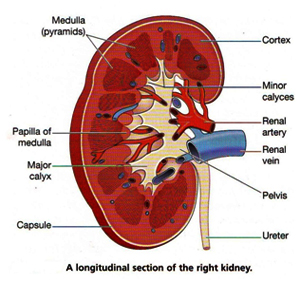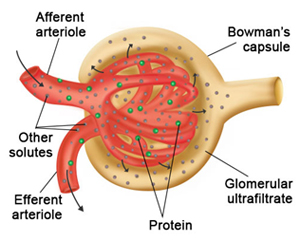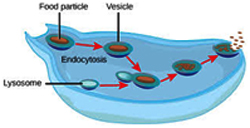4.Excretion– The Waste Disposing System
4. EXCRETION– The Waste Disposing System

Synopsis:
- Excretion is a biological process involved in separation and removal of toxic wastes from body.
- In human beings, the waste products include CO2 , H2O, Nitrogenous compounds like Ammonia, Urea, Uric acid, bile pigments and excess salts etc.
- The most poisonous of all waste products is ammonia.
- The human excretory system comprises a pair of kidneys, a pair of ureters, urinary bladder and urethra.
- The kidney is bean shaped. From the inner side of each kidney has fissure or hilus.
- Through hilus, renal artery enters and renal vein and ureter exit.
- Inside the kidney, dark coloured outer zone called cortex and pale coloured inner zone called medulla.
- Each kidney is composed of more than one million microscopic and thin tubular functional units called nephrons.
- Each nephron has basically two parts; one is Malphigian body and other is renal tubule.
- Malphigian body consists of blind cup shaped end portion of nephron called Bowman’s capsule and a bunch of fine blood capillaries called glomerulus.
- Renal tubule has 3 parts: Proximal Convoluted Tubule (PCT), Loop of Henley and Distal Convoluted tubule (DCT).
- Distal Convoluted Tubule opens into a collecting tubule.
- Collecting tube forms pyramids and calyces which open into the pelvis.
- Pelvis leads into the ureter.
- Formation of urine involves 4 stages;
Glomerulus filtration, Tubular reabsorption, Tubular secretion and Concentration of Urine. - Glomerular filtrate is also called primary urine.
- Useful substances in primary urine are reabsorbed into peritubular network.
- In tubular secretion some other wastes like extra salts, ions of K+, Na+, Cl- and H+ secretes from peritubular capillaries into DCT.
- 75% of water content of the nephric filtrate is reabsorbed in the region of Proximal Convoluted tubule (PCT).
- Kidneys remove nitrogenous waste from body, maintains water balance (Osmoregulation), salt content, pH and blood pressure in human body.
- The artificial kidney that filters wastes from blood is called dialysis machine (William J. Kolff, 1947).
- Urine contains 96% water, 2.5% of organic substances and 1.5% of inorganic solutes.
- Complete and irreversible kidney failure is called ‘End Stage Renal Disease’ (ESRD).
- Dialysis machine is used to filter the blood of the person whose kidneys are damaged. The process is called ‘haemodialysis’.
- Kidney transplantation is permanent solution to renal failure patients.
- The process of transplantation of organs from brain dead patients to another is called ‘Cadaver Transplantation’.
- Lungs, skin, liver have their own specific functions but carry out excretion as a secondary function.
- Different animals have different excretory organs.
SNo.
Phylum
Excretory Organs and Systems
1.
Platyhelmenthes
Flame cells
2.
Annelids
Nephridia
3.
Arthropoda
Green glands, Malphigian Tubules
4.
Mollusca
Meta nephridia
5.
Echindermata
Water vascular system
6.
Reptiles, Birds and Mammals
Kidneys
7.
Porifera, Coelenterates
Water bathes almost all the cells
8.
Protozoa
Simple diffusion.
9.
Plants
No specific organs
- Plants can get rid of excess water by a process like transpiration and guttation.
- In plants, waste products are stored in leaves, bark and fruits.
- In some plants like yam (Pendalam) waste gets stored in fruits in the form solid bodies called raphides.
- Plants metabolites are of 2 types:
- Primary metabolites. Eg: Proteins, carbohydrates and fats.
- Secondary metabolites. Eg: Alkaloids, tannins, latex, resins, gums, etc; these are economically important to us.
- Alkaloids are nitrogenous by-products and poisonous.
- Tannins are carbon compounds used in leather industry and medicines. Eg: Cassia, Acacia.
- Resins occur mostly in Gymnosperms in specialized resin passages. They are used in varnishes.
- Gum is a sticky substance which comes out when branches are cut in plants like Neem, Acacia.
- Latex is a sticky, milky white substance secreted by plants.
- From the latex of Hevea brasiliensis, rubber is prepared and from latex of Jatropa bio-diesel is prepared.
- Excretion is removal of material from living being, whereas secretion is movement of materials from one point to other point.
FOUR MARKS QUESTIONS:
- What is meant by excretion?
Ans:- Excretion is a biological process involved in separation and removal of wastes from the body.
- In Latin ex means out, crenere means shift.
- A number of reactions take place during various metabolic activities. When carbohydrates, proteins and fats are metabolized, carbon dioxide, water, nitrogenous compounds like ammonia, urea, uric acid, bile pigments, excess salt, etc., are produced.
- If the metabolic wastes are not discharged from the body, they become toxic and harm the body.
- Name different excretory organs in human body and excretory material generated by them?
Ans:- Kidneys: Kidneys are the main excretory organs of our body. Lungs, skin and liver also carry out excretion as a secondary function.
- Lungs: In respiratory process lungs remove carbon dioxide and water.
- Skin: It contains large number of sweat glands richly supplied with blood capillaries from which they extract sweat and some metabolic wastes.
The skin sends out plenty of water and small amounts of salts and serves as an excretory organ. - Liver: It produces bile pigments – bilirubin, biliverdin and urochrome, which are metabolic wastes of haemoglobin of dead R.B.Cs. Urochrome is eliminated through urine. Cholesterol and derivatives of steroid hormones, extra drug, vitamins and alkaline salts are also of excreted through bile. Liver is also involved in urea formation.
- Intestine: Excess salts of calcium, magnesium and iron are excreted by large intestine for elimination along with the faces.
- Small amount of nitrogenous wastes are also eliminated through saliva and tears.
- Deepak said that ‘Nephrons are functional units of kidney’. How will you support him?
Ans:- Each kidney is made up of more than one million microscopic and thin tubular functional units called nephrons or uriniferous tubules. Each nephron has two parts. 1) Malpighian body and 2) Renal tubule.
- Malpighian body consists of a cup shaped Bowman’s capsule and bunch of fine blood capillaries called Glomerulus.
- The Bowman’s capsule and Glomerulus together called a Malpighian capsule.
- Renal artery brings oxygenated blood loaded with waste products to Bowmans’s capsule and divided into small afferent arterioes formed into glomerulus. It gives rise to an efferent arteriole.
- Bowman’s capsule is lined by a single layer of squamous epithelial cell called podocyte cells. There are fine pores between podocyte cell to allow passage of materials filtered out of glomerulus.
- Renal tubule has three parts 1) Proximal Convoluted Tubule (PCT) 2) Loop of Henle which is ‘U’ shaped and 3) Distal Convoluted Tubule (DCT).
- Distal convoluted tubule opens into a collecting tube. The collecting tube forms pyramids and calyces which open into the pelvis. Pelvis leads into ureter.
- All the parts of the renal tubule are covered by a network of peritubular capillaries formed from efferent arteriole. These capillaries join to form renal venule.
- Formation of urine involves four stages 1) Glomerular filtration 2) Tubular secretion and 4) Concentration of urine.
- Blood flows inside the glomerulus and waste molecules, nutrient molecules and water are filtered and enter the Bowman’s capsule by ultrafiltration and passes into proximal convoluted tubule.
- The peritubular capillaries around PCT reabsorb all the useful components like glucose, amino acids, Vitamin – C, potassium, sodium, chlorides and 75% of water in the P.C.T, Loop of Henle and DCT.
- tubular secretion is the active secretion where the products like urea, uric acid, creatinine, salt ions like K+ , Na+ and H+ ions, by blood capillaries into the urinary tubule.
- The concentrated urine with waste products enters into ureters then into urinary bladder. When urine is stored about 300 – 800 ml, it excretes outside through the opening called urethra.
Hence I support Deepak’s statement that the functions of Nephron are vital to life.
- How do plants manage the waste materials?
Ans:- Plants do not have specific organs to excrete the waste materials which are formed in the metabolism.
- Plants produced carbon dioxide and water wastes in the process of respiration; oxygen is produced in the photosynthesis process and these exit through stomata of leaves and lenticels of stem.
- They get rid of excess water by the process of transpiration and guttation.
- The waste products may be stored in leaves, bark and fruits. When these dead leaves, bark, and ripe fruits fall off from the tree then the waste products in them are get rid of from the plants.
- Some of the plants waste gets stored in the fruits in the solid bodies called Raphides. Ex : Yam.
- Several plants prepare chemicals and store them in roots, leaves, seeds for protection against herbivores. These chemicals are unpleasant to taste and hence herbivores do not prefer to eat such plants.
- Why do some people need to use a dialysis machine? Explain the principle involved in it?
Dialysis machine

Ans:- Kidney failure is sometimes called End Stage Renal Disease (ESRD). If kidneys stop working completely, our body will be filled with extra waste products. This condition is called uremia.
- Dialysis machine is used to filter the blood of a person whose kidneys are damaged. The process is called haemodialysis.
- In this process blood is taken out from the main artery, mixed with an anticoagulant, such as heparin, and then pumped into the apparatus called dialyzer.
- In this apparatus blood flows through channels or tubes. These tubes are embedded in the dialyzing fluid.
- The membrane separates the blood flowing inside the tube, and dialyzing fluid (dialysis), which has the same composition as that of plasma, except the nitrogenous wastes.
- As nitrogenous wastes are absent in dialyzing fluids, these substance from the blood move out freely, thereby cleaning the blood of its wastes. This process is called dialysis.
- This is similar to function of the kidney but there is no reabsorption involved.
- The cleaned blood is pumped back to the body through a vein after adding antiheparin.
- Do you find any relationship between circulatory system and excretory system? What are they?
Ans:- Circulatory system consists of Heart, Blood and Blood vessels. Excretory system consists of kidney, Lungs, Skin and Liver.
- Circulatory system distributes oxygenated blood, digested food materials, hormones, water to all the body cells and the wastes produced in the body cells due to metabolic activities and brings these wastes to the excretory organs where they are not to be removed.
The excretory system removes the cellular wastes and excess water from the circulatory system. - Circulatory system brings carbon dioxide and water to lungs. Lungs remove carbon dioxide and water in the process of respiration.
- Skin contains large number of sweat glands richly supplied with blood vessels.
As skin is the excretory organ, it extracts sweat and metabolic wastes from circulatory system and sends them outside. - Liver produces bilirubin, biliverdin and urochrome – the metabolic wastes of haemoglobin of dead R.B.Cs brought to kidneys by circulatory system.
These wastes are excreted through urine. -
Thus there is a relationship between circulatory system and excretory system in keeping the blood clean and keeping the body healthy and functioning at its best.
-
Write differences
A) Functions of PCT and DCT
B) Kidney and artificial kidneyC) Excretion and secretionWhat are the differences between PCT and DCT?
D) Primary metabolites and secondary metabolites Ans: A) Functions of PCT and DCT:PCT
DCT
1). PCT (Proximal Convoluted Tubule) is the first part of the Renal Tubule.
1). DCT (Distal Convoluted Tubule) is the last part of the Renal Tubule.
2). PCT receives primary urine from Glomerulus.
2). DCT receives urine after reabsorption in PCT, through loop of Henle.
3). The peritubular capillaries around PCT reabsorb all the useful componenets of primary urine such as Glucose, Amino acids, Vitamin – C, Potassium, Calcium, Sodium, Chlorides and 75% of water.
3). The active secretion of waste products takes place by blood capillaries into the urinary tubule : Removal of all the waste products from blood like urea, uric acid, creatinine, salt ions like K+, Na+ and H+ ions.
4). PCT opens into Loop of Henle.
4). DCT opens into a collecting tube.
B) What are the differences between Kidney and Artificial Kidney?Kidney
Artificial Kidney
1). Human excretory system consists of a pair of kidneys, a pair of ureters, urinary bladder and urethra.
1). The artificial kidney is the apparatus called dialyzer. The parts of excretory system (kidneys, ureters, urinary bladder and urethra) are absent.
2). Nitrogenous wastes are filtered in the glomerulus of the kidneys.
2). Dialysis machine is used to filter the nitrogenous wastes from the blood.
3). The filtration in the glomerulus is called pressure filtration or ultra filtration.
3). The process is called haemodialysis.
4). Blood flows through renal arterioles.
4). In this apparatus, blood flows through channels on tubes.
5). Fine pores between podocyte cells allow the passage of materials filtered out of glomerulus.
5). The membrane separates the blood flowing inside the tube.
6). Along with the nitrogenous waste materials, the useful components, salts and water are also present in the filtered material.
6). The dialyzing fluid has the same composition as that of plasma, except nitrogenous wastes.
7). Anticoagulant heparin is present in the blood vessels.
7). Heparin is added into the blood before pumping into the apparatus.
C) What are the differences between Excretion and Secretion?Excretion
Secretion
1). Excretion is the removal of material from living beings.
1). secretion is the movement of materials from one point to other point.
2). Excretion is passive in nature.
2). Secretion is active in nature.
3). Humans excrete materials such as tear, urine, CO2 and sweat.
3). Secretion includes enzymes, hormones and saliva.
4). In plants excretion is done through roots, leaves and bark.
4). Secretions occur in the plant body in the from of latex, resins, gums, etc.
D) What are the differences between Primary metabolites and secondary metabolites?
Ans: The biochemical substances produced in plants are of two types –
i. Primary metabolites, and
ii. Secondary metabolites.
The materials like carbohydrates, fats and primary metabolites, which are required for growth and development are called primary metabolites.
The secondary metabolites are Alkaloids, Tannins, Resins, Gums and Latex, which are not used for growth and development.
Plants produce these chemicals for their use. Man found the usage of these secondary metabolites for other benefits.
-
There is a pair of bean-shaped organs P in the human body towards the back, just above the waist. A waste product Q formed by the decomposition of unused proteins in liver is brought into organ P through blood by an artery R. the numerous tiny filters S present in organ P clean the dirty blood goes into circulation through a vein T. The waste substance Q, other waste salts and excess water from a yellowish liquid U which goes from organ P into a bag like structure V through two-tube W. This liquid is then thrown out of the body through a tube X.
a) What is (i) organ P and (ii) waste substance Q.
Ans: i) The organ P is kidney.
ii) The waste substance Q is bilirubin and biliverdin produced during decomposition of haemoglobin.
b) Name (i) artery R and (ii) vein T.
Ans: R is Renal Artery
T is Renal Vein
c) What are tiny filters S known as?
Ans: The tiny filters ‘S’ are Renal arterioles.
d) Name (i) liquid U (ii) structure V (iii) tubes W (iv) tube X.
Ans: i) Liquid U is urine ii) Structure V is Urinary bladder iii) Tubes W is ureters iv) Tube X is urethra.
-
The organ A of a person has been damaged completely due to poisonous waste material B has started accumulation in his blood, making it dirty. In order to save this person’s life, the blood from an artery in the person’s arm is made to flow into long tubes made of substance E which are kept in coiled from in a tank containing solution F. this solution contains three materials G, H and similar proportions to those in normal blood. As the person’s blood passes through long tubes of substance E, most if the wastes present in it go into solution. The clean blood is then put back into solution. The clean blood is then put back into a vein in the person for circulation.
a) What is organ A?
Ans: The organ A is the kidney.
b) Name the wastes substance B.
Ans: Nitrogenous waste substance.
c) What are (i) E, and (ii) F?
Ans: E is the blood flowing inside the tube. F is dialyzing fluid.
d) What are G, H and I?
Ans: Waste molecules, nutrient molecules and water.
e) What is the process described above known as?
Ans: The process described above known as ‘DIALYSIS’.
- To keep your kidneys healthy for long period what question will you ask a nephrologist / urologist?
Ans: To keep our kidneys healthy for long period we can ask the following questions:- How can we know that there is a problem in the kidneys?
- In which conditions Renal diseases do occur?
- What is ESRD?
- Which symptoms can be found before renal failure?
- How can we protect the kidney?
- How can we avoid renal infections?
- Is dialysis a safe method?
- What are the safe methods to keep the kidneys healthy?
- What are the preventive steps to be taken?
- What are the treatments for renal infections?
- What are the gum yielding trees in your surroundings? What procedure you should follow to collect gum from trees?
Ans: Plants like Neem, Acacia secrete a sticky substance called gum.
Procedure :- To obtain gum branches are cut or a cut is made on the stem or a branch.
- A vessel is arranged at the cut portion.
- To heal the cut portion the gum secretes out by absorbing water and helps in the healing of damaged parts of plants.
- The gum which secretes out into the vessels is collected.
Uses:- Gums are economically valuable being used as adhesive.
- They are used as binding agents.
- They are used in the preparation of medicines.
- Collect the information about uses of different kinds of alkaloids, take help of library.
Ans: Alkaloids are the nitrogenous by-products and poisonous. These are stored in different parts of the plants.
Alkaloid
Plant
Part
Uses
Quinine
Cinchona officinalis (Cinchona)
Bark
Antimalarial drug
Nicotine
Nicotiana tabacum (Tobacco)
Leaves
Insecticide
Morphine, Cocaine
Papaver somniferum (Opium)
Fruit
Pain killer
Reserpine
Rauwolfia serpentina (Snake root)
Root
Medicine for snake bite
Caffeine
Coffea Arabica (Coffee plant)
Seed
Central nervous system stimulant
Nimbin
Azadirachta indica (Neem)
Seeds, Bark, Leaves
Antiseptic
Scopolamine
Datura stramonium
Fruit, flower
Sedative
pyrethroids
Chrysanthemum
Flower
Insecticides
- Draw a neatly labeled diagram of L.S of kidney.

- Describe the structure of renal tubule with neatly labled diagram.
Ans: Structure of Renal tubule:

- It has three parts 1) Proximal Convoluted Tubule 2) Loop of Henle and 3) Distal Convoluted Tubule.
- Distal convoluted tubule opens into a collecting tubule.
- All the parts of the renal tubule are covered by a network of peritubular (around tube) capillaries formed from efferent arteriole.
- The peritubular capillaries join to form renal venule.
- Draw a block diagram showing the path way of excretory system in human being.
Ans:

- List out the things that make you amazing in excretory system of human being.
Ans:- Kidneys remove garbage from our body. They also work to balance the amount of vitamins, fat and protein that are found in the blood. They do this so that our body can easily perform the day-to-day activities.
- The right and left kidneys are assisted by a number of organs in the body which help in disposing waste products.
- Our intestine makes solid waste material and is excreted through digestive tract.
- Each day our body eliminates around 1.6 to 1.8 litres all of the liquids, minerals and vitamins that are of no use to the body are contained the urine.
- The bladder of a human body is nearly the same size as the average of human brain.
- In one individuals life span, the liver can produce around 184.275 kgs of bile (6500 ounces).
- In one life span, an individual could urinate close to 7,850,000,000 gallons of fluid.
- There are two kidneys in the human body. The left kidney is always found higher than the right kidney.
- An extraordinary fact regarding the excretory system is that up to 400 ml of urine can be held in human bladder.
- Skin is also an excretory organ responsible for elimination of wastes through sweat along with various toxins.
- Urine contains a high amount of urea which can be used by plants as a source of nitrogen. Because of this diluted urine can be used in gardens and potted plants.
- You read about ‘Brain dead’ in this chapter. What discussions would you like to have? Why do you think so?
Ans: Daily 10 to 100 people are met with accidents in our state. Out of them some people suffer from ‘Brain Dead’. The nervous system does not function in this situation or it stops completely. The functioning of other organs like circulation, excretion etc., will take place. The person may live for few hours and there will no further chance for living.
So if we collect organs from brain dead patients in time, we can save minimum 5 person’s life. So many patients with severe diseases are waiting for suitable organ donors. If we collect organs from the brain dead people, we can save such people.
By donating organs, we can give life to the people with diseases, who are waiting for organ donation. Organ transplantation facility is available only in two government hospitals in Hyderabad viz. - NIMS and Osmania Hospital and also available in more than 10 corporate hospitals. We can transplant organs like kidney, liver, heart, lungs, pancreas, skin, bone, intestines and eye (cornea).
So it is our duty to bring awareness on organ donation and informing about Brain Dead patients to the medical personnel from government and private hospitals.
- After learning this, what habits you would like to charge or following for proper functioning of kidneys?
Ans:- I always eat the home cooked meals. Canned foods, fast foods, restaurant foods and highly processed food cause malfunctioning of kidney. I avoid eating the above food items.
- I should adopt to take low salt diet to help controlling blood pressure and slow down kidney damage.
- Eating low-protein food can help to decrease levels of urea and improve kidney function.
- I replace high protein food like meat, eggs and milk products with lower protein options like grains and vegetables.
- I avoid eating products that contain refined sugar such as cakes, pies, cookies, candies and pastries.
- I replace the above food items with fruits containing simple carbohydrates.
- High sodium content in the food damages kidneys. Hence I avoid foods that are high in sodium including potato chips, bacon (cured meat from back or sides of pig), cheese, meat, canned vegetables, canned soups, frozen dinners and table salt.
- Spices that do not contain sodium can be used to add flavor to food without increasing sodium intake.
- I avoid taking high phosphorus foods such as cheese, cola soft drinks, butter and I replace them with lower phosphorus foods such as soft drinks, sharbat etc.
- Potassium levels in the body are kept at normal levels by kidneys. So I eat food with low potassium levels.
- Potassium levels are low in apples, watermelon, cucumber, grapes, cherries and carrot. High potassium levels cause irregular heartbeats.
- If you want to explain the process of filtration in kidney what diagram you need to draw?
 Filtration in the Glomerulus and capsule
Filtration in the Glomerulus and capsule
Two Mark Questions
-
How are waste products excreted in amoeba?

Ans: Specific excretory organs are absent in unicellular organisms. These organisms remove waste products by simple diffusion from the body surface into the surrounding water.
Fresh water organisms like Amoeba, Paramoecium possess osmoregulatory organelle called contractile vacuole.
Water and waste from the body is collected into the contractile vacuole. This vacuole swells up, reaches the surface and bursts to release its content to outside.
- What is meant by osmoregulation? How is it maintained in human body?
Ans:- Maintaining the correct amount of water, ionic balance in the body is osmoregulation. Kidney is the chief osmoregulatory organ of our body.
- Kidneys with their osmoregulatory activity keep all our body fluids (blood, lymph, tissue fluid) in a steady concentration.
- If this condition fails, all the physiological activities of our body collapse. The Nephrons in the kidney filter the impure blood containing metabolic wastes.
- Nephrons have the ability to separate nitrogenous metabolic wastes, impurities from the blood and mix them with water forming urine.
- The useful materials like glucose, water, mineral ions like sodium and potassium are retained by the body with the help of kidneys.
- Give reasons.
A) Always vasopressin is not secreted.
Ans:- The functioning of the kidneys is also associated by the posterior lobe of pituitary gland, which secretes a hormone vasopressin.
- This hormone will influence the retention of the water by kidney tubules from blood which will help to maintain the steady state concentration of blood and other body fluids.
- Vasopressin is secreted only when concentrated urine is to be passed out. Absence of vasopressin hormone produces dilute urine. 4) Hormone action maintains osmotic concentration of body fluids. Deficiency of vasopressin causes excessive, repeated urination (Diabetes insipidus).
B) When urine is discharged, in beginning it is acidic in nature later it becomes alkaline.
Ans: Urine contains 96% of water 2.5% of organic substances like urea, uric acid, creatine, creatinine, water soluble vitamins, hormones and oxalates etc., and 1.5% of inorganic solutes like sodium, chloride, phosphate, sulphate, magnesium, calcium, iodine.
It is acidic in the beginning, but becomes alkaline on standing due to decomposition of urea to from ammonia.
C) Diameter of afferent arteriole is bigger than efferent arteriole.
Ans: The diameter of the efferent arteriole is less so as to create pressure. Due to this the blood remains in the glomerulus more time and the filtration of the waste takes more time.
Bowman’s capsule which accommodates one glomerulus is lined by a single layer of squamous epithelial cells called podocyte cells. There are fine pores to allow passage of materials filtered out of glomerulus.
- What are the differences between Excretion and Secretion?
Ans:ExcretionSecretion1). Excretion is the removal of material from living beings.1). secretion is the movement of materials from one point to other.2). Excretion is passive in nature.2). Secretion is active in nature.3). Humans excrete materials such as tear, urine, CO2 and sweat.3). Secretion includes enzymes, hormones and saliva.4). In plants excretion is done through roots, leaves and bark.4). Secretions occur in the plant body in the form of latex, resins, gums, etc. - Imagine what happens if waste materials are not sent out of the body from time to time?
Ans:- Kidney failure is sometimes called End Stage Renal Disease (ESRD). If kidneys stop working completely, our body is filled with extra water and waste products. This condition is called uremia.
- Our hands or feet may swell and feel tired and weak, because the body needs clean blood to function properly.
- Kidneys are vital organs for our survival. Several factors such as infections, injury, very high blood pressure and sugar restrict the blood flow to kidneys. This leads to accumulation of poisonous wastes in the body and leads to death.
- Our people have very less awareness about organ donation. To motivate people prepare slogans about organ donation.
Ans:Slogans about organ donation:- Help someone to live after death.
- Be an organ donor, all it costs is little love.
- At last you die, donate your eyes.
- Help a generation with organ donation.
- Let someone see through your eyes what you have seen.
- Have a heart-Save a life.
- Organ donation saves lives.
- Organ donation is a gift for life.
One Mark Questions
- What is the most poisonous of all waste products?
Ans: Ammonia is the most poisonous of all waste products of metabolism.
- What is the meaning of excretion in Latin?
Ans: In Latin ‘ex’ means out, ‘crenere’ means shift. Excretion is the biological process involved in separation and removal of wastes from body.
- What are the parts of excretory system?
Ans: Excretory system consists of a pair of kidneys, a pair of ureters, urinary bladder and urethra.
- In which animals, excretion takes place by diffusion?
Ans: In the animals belonging to the Phylum Protozoa, Coelenterata and Echinodermata, dissolved wastes are eliminated by diffusion through body surface.
- In which animals, flame cells are the excretory organs?
Ans: Flame cells are the excretory organs in flat worms like Planaria.
- Name the excretory organs in Arthropods.
Ans: In Arthropods, Malpighian tubules take care of excretion.
- How do excretory organs function in all vertebrates?
Ans: In Molluscs, nephridia are grouped to from a kidney.
- What are the excretory organs in all vertebrates?
Ans: In all vertebrates, kidneys are the excretory organs.
- What are the other excretory organs of human body?
Ans: Kidneys are the chief excretory organs of human body. Lungs, Skin, Liver have their own specific functions, but they carry out excretion as a secondary function.
- What are Sebaceous Glands? What is their function?
Ans: Sebaceous glands are also called oil glands in skin. They eliminate sebum an oily substance which contains waxes, sterols, hydrocarbons and fatty acids.
- Name the bile pigments.
Ans: Bilirubin, Biliverdin and urochrome are the bile pigments.
- Excess salts of calcium, magnesium and iron and excreted by epithelial cells of a colon (large intestine) for elimination along with the faeces.
- When was the first kidney transplantation performed?
Ans: The first kidney transplantation was performed between identical twins in 1954 by Dr. Charles A. Hufnagel, a surgeon based out of Washington.
- How do you appreciate the 18 years old H.S. Yaswanth kumar’s father for donating the organs of his brain dead son?
Ans: We shall appreciate the father for his humane act, where no one can dare to take such a courageous step or think of donating the organs of his brain dead son.
- What does the society need about organ donation?
Ans: The society needs much awareness as to organ donation so that we can save many lives who are in need of different organs for their survival.
- What are the organs generally transplanted?
Ans: The organs like kidney, liver, lungs, pancreas, skin, bone, intestine and eye (cornea) can be transplanted from the donors.
- What is chewing gum? How is it made of?
Ans: Chewing gum is a type of gum for chewing made dates back 5000 years. Modern chewing gum is originally made of chicle, natural latex from plant.
- What happens if harmful products are not removed from our body every day?
Ans: If the waste materials which are harmful are not removed from our body every day, it leads to diseases.
- Why is more urine produced in winter?
Ans: When we are in cold environment, blood flow to our internal organs is increased, to keep our organs warm. The increase in the blood flow to the kidneys causes more blood to be filtered. Thus more urine is produced in winter.














